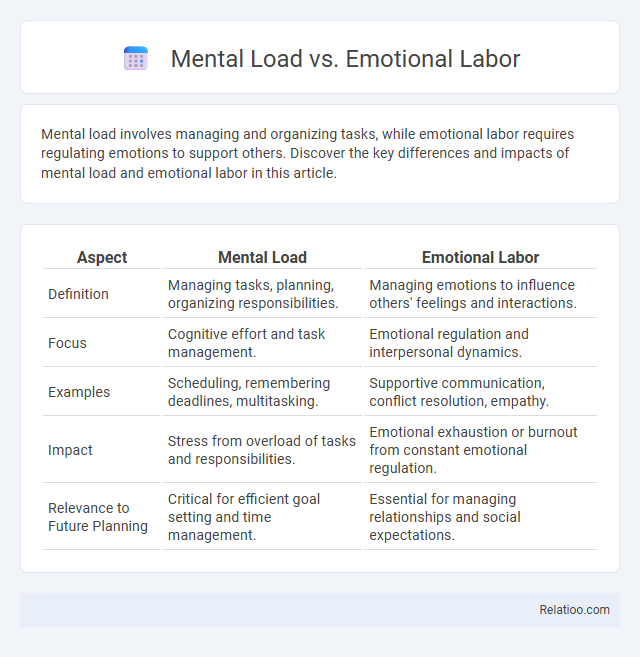Mental load involves managing and organizing tasks, while emotional labor requires regulating emotions to support others. Discover the key differences and impacts of mental load and emotional labor in this article.
Table of Comparison
| Aspect | Mental Load | Emotional Labor |
|---|---|---|
| Definition | Managing tasks, planning, organizing responsibilities. | Managing emotions to influence others' feelings and interactions. |
| Focus | Cognitive effort and task management. | Emotional regulation and interpersonal dynamics. |
| Examples | Scheduling, remembering deadlines, multitasking. | Supportive communication, conflict resolution, empathy. |
| Impact | Stress from overload of tasks and responsibilities. | Emotional exhaustion or burnout from constant emotional regulation. |
| Relevance to Future Planning | Critical for efficient goal setting and time management. | Essential for managing relationships and social expectations. |
Understanding Mental Load: Definition and Scope
Mental load refers to the cognitive effort involved in managing and organizing daily tasks, responsibilities, and planning, often invisible yet mentally exhausting. Emotional labor involves managing and regulating your emotions to fulfill the emotional requirements of a job or relationship, distinct from the cognitive strain of mental load. Understanding mental load helps you identify the comprehensive scope of mental responsibilities beyond physical tasks, enabling better balance and mental well-being.
Defining Emotional Labor: Key Characteristics
Emotional labor involves managing and regulating emotions to fulfill the emotional requirements of a job, often requiring employees to display specific feelings regardless of their true emotions. Key characteristics include surface acting, where individuals fake emotions, and deep acting, where they attempt to genuinely feel the required emotions. This type of labor is distinct from mental load, which encompasses the cognitive effort in managing tasks and responsibilities, and differs from general emotional stress by focusing on workplace emotional regulation.
The Overlap: Where Mental Load Meets Emotional Labor
Mental load and emotional labor often intersect in the daily management of responsibilities and relationships, where you must balance cognitive tasks with the regulation of emotions. Both require ongoing mental effort: mental load involves organizing and planning tasks, while emotional labor centers on managing feelings and social interactions. Understanding this overlap highlights the complex demands placed on your mental resources, affecting overall well-being and stress levels.
Gender Roles and Societal Expectations
Mental load involves managing household tasks and planning, often disproportionately borne by women due to traditional gender roles reinforcing caretaking expectations. Emotional labor entails regulating emotions to support others, a burden frequently placed on women as society expects them to maintain relational harmony. Societal expectations perpetuate these intersecting demands, intensifying stress and limiting equitable role distribution between genders.
Real-Life Examples: Everyday Scenarios
Mental load involves managing and organizing household tasks, such as remembering appointments, grocery lists, and meal planning, while emotional labor refers to regulating and expressing emotions to maintain harmony in relationships, like soothing a partner's stress or managing children's feelings. For example, you might experience mental load when coordinating family schedules, whereas emotional labor occurs when you diffuse tension during a disagreement. Recognizing these distinctions helps you balance your responsibilities and emotional well-being in everyday scenarios like childcare, work, and managing social dynamics.
The Impact on Mental Health and Wellbeing
Mental load involves the constant cognitive effort of managing tasks and responsibilities, which can lead to stress and burnout when unrecognized or unsupported. Emotional labor requires regulating emotions to meet workplace or social expectations, often causing emotional exhaustion and decreased psychological wellbeing. Both forms of labor significantly impact mental health, contributing to anxiety, depression, and reduced overall wellbeing when sustained without adequate coping mechanisms or external support.
Recognizing Invisible Work in Relationships
Mental load involves the constant mental organization and planning of tasks, while emotional labor refers to managing and regulating emotions to support others, often without visible acknowledgment. Recognizing invisible work in relationships means valuing both the cognitive effort of mental load and the emotional efforts behind emotional labor, which are critical yet frequently overlooked components of partnership dynamics. Awareness of these hidden contributions promotes equity and empathy, fostering healthier and more balanced relationships.
Strategies for Balancing Responsibilities
Effective strategies for balancing mental load and emotional labor involve clear communication and boundary-setting to distribute tasks evenly and reduce cognitive overwhelm. Prioritizing self-care and mindfulness practices supports emotional resilience and prevents burnout from constant mental management of responsibilities. Utilizing tools like shared calendars and task management apps enhances organization, making it easier to track obligations and maintain a healthier work-life balance.
Supporting Each Other: Tools for Change
Supporting each other in managing mental load, emotional labor, and physical load requires practical tools such as communication frameworks, shared responsibility checklists, and time management apps to ensure equitable distribution of tasks. Implementing these tools fosters awareness and accountability, reducing stress and improving relational dynamics. Leveraging technology and collaborative planning helps create sustainable systems for balancing cognitive, emotional, and physical demands within households and workplaces.
Building Awareness: Toward Equal Emotional Sharing
Mental load involves the cognitive effort of managing household tasks and schedules, while emotional labor refers to managing and regulating emotions to support others, often unnoticed. Building awareness of these distinctions promotes equal emotional sharing by encouraging equitable distribution of invisible work in relationships and workplaces. Acknowledging both mental load and emotional labor helps dismantle gendered expectations and fosters balanced emotional responsibilities.

Infographic: Mental Load vs Emotional Labor
 relatioo.com
relatioo.com